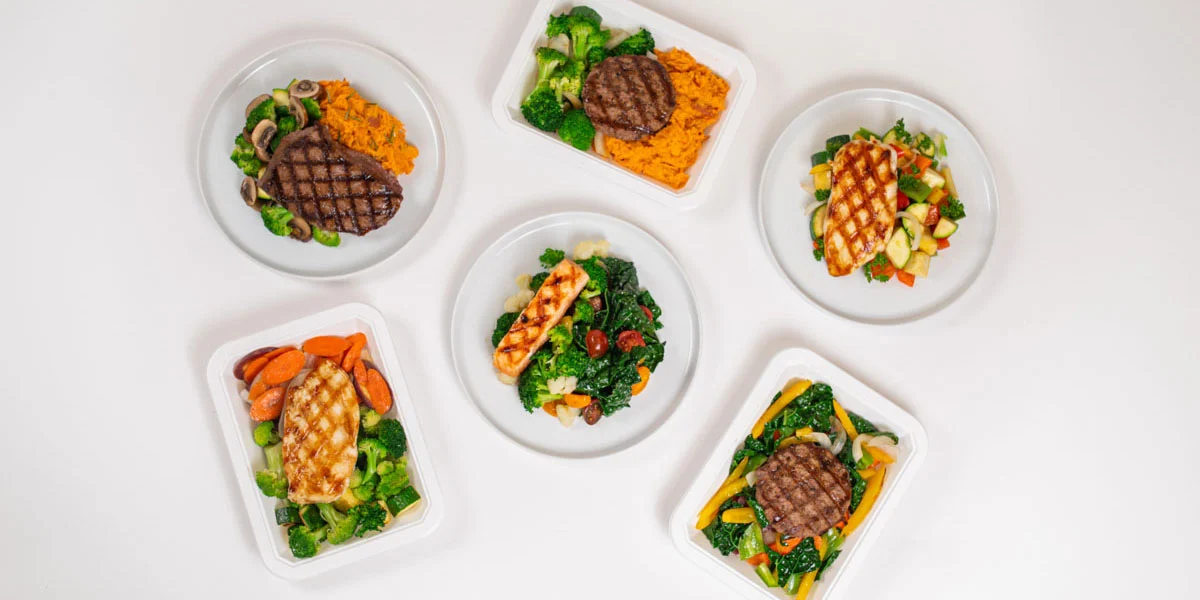MealPrep is an effective strategy for individuals looking to save time, reduce food waste, and maintain a healthier diet. By planning and preparing meals in advance, you can ensure that nutritious options are readily available, making it easier to stick to your health goals amidst a busy schedule. This article will guide you through the fundamentals of MealPrep, including essential tools, creative recipes, and practical tips for storing and reheating meals safely. Whether you’re a busy professional or a parent managing multiple responsibilities, these insights will help you streamline your meal preparation process and enjoy healthier eating habits.
In this article you will find:
Understanding the Basics of MealPrep for Busy Lifestyles
In today’s fast-paced world, finding time to prepare healthy meals can feel like an overwhelming challenge. However, MealPrep offers a practical solution that not only saves time but also promotes healthier eating habits. By dedicating a few hours each week to prepare meals in advance, you can simplify your weekly routine and make nourishing choices more accessible.
What is MealPrep?
MealPrep involves planning and preparing meals ahead of time, typically for the week. This method allows you to control your portions, reduce food waste, and ensure that you have nutritious options readily available. Whether you’re a busy professional, a parent juggling multiple responsibilities, or someone looking to maintain a healthy lifestyle, understanding the fundamentals of MealPrep is essential.
Key Benefits of MealPrep
Embracing MealPrep comes with a variety of advantages:
- Time Efficiency: Preparing meals in bulk saves you time throughout the week, allowing you to focus on other priorities.
- Cost Savings: Buying ingredients in bulk and reducing takeout can significantly lower your grocery bills.
- Healthier Choices: MealPrep encourages the consumption of whole, nutritious foods, helping you avoid unhealthy fast food options.
- Portion Control: Pre-portioning meals can assist in managing calorie intake and promote weight management.
Getting Started with MealPrep
To successfully integrate MealPrep into your busy lifestyle, consider the following steps:
- Set Your Goals: Determine what you want to achieve with MealPrep. Are you aiming to eat healthier, save time, or reduce food costs?
- Plan Your Meals: Create a weekly menu that includes breakfast, lunch, dinner, and snacks. Focus on balanced meals that incorporate protein, vegetables, and healthy fats.
- Choose Your Recipes: Select simple, quick recipes that can be prepared in bulk. Look for meals that store well and can be easily reheated.
- Make a Grocery List: Based on your meal plan, compile a shopping list to ensure you have all the necessary ingredients.
- Schedule Your Prep Time: Dedicate a specific day and time each week for MealPrep. Treat it like an important appointment to ensure consistency.
Common Mistakes to Avoid
While MealPrep can be incredibly beneficial, there are some common pitfalls to watch out for:
- Overcomplicating Meals: Stick to simple recipes that don’t require extensive preparation or cooking time.
- Neglecting Variety: Eating the same meals can lead to boredom. Incorporate a variety of ingredients and flavors to keep things interesting.
- Ignoring Storage: Invest in quality containers that are suitable for freezing and microwaving to maintain the freshness of your meals.
By understanding the basics of MealPrep, you can create a sustainable routine that fits seamlessly into your busy lifestyle. The next step is to gather the essential tools and containers that will facilitate your MealPrep journey, ensuring that you have everything you need to succeed.
Essential Tools and Containers for Successful MealPrep
To maximize the benefits of MealPrep, having the right tools and containers is crucial. These essentials not only streamline the preparation process but also help maintain the quality and freshness of your meals. Here’s a comprehensive guide to the must-have items that will make your MealPrep experience efficient and enjoyable.
Kitchen Tools for MealPrep
Investing in the right kitchen tools can significantly enhance your MealPrep efficiency. Here are some key items to consider:
- Sharp Knives: A good set of sharp knives is essential for quick and precise chopping, dicing, and slicing. Consider investing in a chef’s knife, paring knife, and serrated knife for versatility.
- Cutting Boards: Use separate cutting boards for fruits, vegetables, and proteins to avoid cross-contamination. Opt for durable, easy-to-clean materials such as bamboo or plastic.
- Food Processor: A food processor can save time by quickly chopping, shredding, or pureeing ingredients. It’s particularly useful for preparing sauces, dips, and even cauliflower rice.
- Measuring Cups and Spoons: Accurate measurements are key to replicating recipes. Invest in a set of measuring cups and spoons to ensure your ingredients are perfectly portioned.
- Mixing Bowls: A variety of mixing bowls in different sizes is useful for combining ingredients, marinating proteins, or storing prepped items.
Containers for Storing MealPrep
Choosing the right containers is essential for keeping your meals fresh and organized. Here are some recommendations:
- Glass Meal Prep Containers: Glass containers are durable, microwave-safe, and help keep food fresh without absorbing odors. Look for containers with airtight lids to prevent spills and leaks.
- Plastic Meal Prep Containers: Lightweight and often more affordable, plastic containers are great for on-the-go meals. Ensure they are BPA-free and microwave-safe for added safety.
- Reusable Silicone Bags: These eco-friendly alternatives to plastic bags are perfect for storing snacks, marinating proteins, or freezing portions of meals. They are flexible, easy to clean, and can be reused multiple times.
- Labeling Supplies: Use labels or a marker to date your meals and indicate their contents. This helps you keep track of freshness and prevents confusion when grabbing meals from the fridge or freezer.
Time-Saving Appliances
In addition to basic kitchen tools, consider these time-saving appliances that can make MealPrep even easier:
- Slow Cooker: A slow cooker allows you to prepare hearty meals with minimal effort. Simply add your ingredients in the morning, and come home to a delicious, ready-to-eat meal.
- Instant Pot: This versatile appliance can pressure cook, slow cook, sauté, and even steam. It’s perfect for preparing grains, beans, and stews quickly, saving you hours in the kitchen.
- Blender: A high-quality blender is essential for smoothies, soups, and sauces. Look for one that can handle ice and frozen ingredients for the best results.
With the right tools and containers, you can streamline your MealPrep process and set yourself up for success. These essentials not only save time but also enhance the quality of your meals, making healthy eating a breeze. Once you have your kitchen equipped, you can move on to exploring creative and nutritious MealPrep recipes that will keep your menu exciting.
Creative and Nutritious MealPrep Recipes to Try This Week
MealPrep doesn’t have to be boring or repetitive. With a little creativity, you can prepare delicious and nutritious meals that keep you excited about eating healthy throughout the week. Here are some innovative MealPrep recipes that are not only easy to prepare but also packed with flavor and nutrients.
Breakfast Ideas
Start your day off right with these wholesome breakfast options:
- Overnight Oats: Combine rolled oats with your choice of milk (dairy or plant-based), yogurt, and toppings like fruits, nuts, and seeds. Prepare several jars at once and let them sit in the fridge overnight. Try variations like banana and almond butter or berry and chia seed.
- Veggie Egg Muffins: Whisk eggs and mix in your favorite chopped vegetables such as spinach, bell peppers, and onions. Pour the mixture into a muffin tin and bake until set. These protein-packed muffins are perfect for a quick breakfast on the go.
- Quinoa Breakfast Bowl: Cook quinoa and top it with almond milk, sliced bananas, and a drizzle of honey or maple syrup. Add a sprinkle of cinnamon for extra flavor. This hearty bowl provides a great source of protein and fiber to kickstart your day.
Lunch Options
Keep your lunch exciting with these nutritious recipes:
- Chickpea Salad: Toss canned chickpeas with diced cucumbers, cherry tomatoes, red onion, and parsley. Dress with olive oil, lemon juice, salt, and pepper. This refreshing salad is high in protein and can be served on its own or as a filling for wraps.
- Turkey and Spinach Wraps: Spread hummus on whole grain wraps and layer with sliced turkey, fresh spinach, and shredded carrots. Roll tightly and slice into pinwheels for a satisfying lunch that’s easy to pack and eat on the go.
- Brown Rice and Black Bean Bowl: Cook brown rice and mix it with black beans, corn, diced avocado, and salsa. Top with a squeeze of lime juice for a zesty flavor. This bowl is rich in fiber and can be customized with your favorite toppings.
Dinner Delights
End your day with these flavorful dinner recipes:
- Sheet Pan Chicken and Vegetables: Place chicken breasts, broccoli, bell peppers, and sweet potatoes on a sheet pan. Drizzle with olive oil, garlic, and your favorite herbs. Roast until everything is cooked through for a complete meal in one dish.
- Vegetable Stir-Fry: Sauté a mix of colorful vegetables like bell peppers, broccoli, and snap peas in a bit of sesame oil. Add tofu or chicken for protein and serve over brown rice or quinoa. This dish is quick to prepare and packed with nutrients.
- Lentil Soup: Cook lentils with diced tomatoes, carrots, celery, and spices like cumin and coriander. Simmer until the lentils are tender. This hearty soup can be stored in the fridge or frozen for later, making it a perfect MealPrep option.
Snack Ideas
Don’t forget about snacks! These easy options will keep you fueled throughout the day:
- Energy Bites: Combine oats, nut butter, honey, and mix-ins like chocolate chips or dried fruit. Roll into bite-sized balls and refrigerate. These no-bake snacks are perfect for a quick energy boost.
- Veggies and Hummus: Pre-cut an assortment of fresh vegetables such as carrots, bell peppers, and cucumbers. Pair them with individual containers of hummus for a healthy, crunchy snack.
- Greek Yogurt Parfaits: Layer Greek yogurt with granola and fresh berries in small containers. These parfaits make for a delicious and nutritious snack or dessert.
These creative and nutritious MealPrep recipes not only save time but also ensure you have delicious options at your fingertips throughout the week. By incorporating a variety of flavors and ingredients, you can maintain excitement in your meals and support your health goals. Next, let’s explore some practical tips for storing and reheating your MealPrep meals safely to keep them fresh and delicious.
Tips for Storing and Reheating MealPrep Meals Safely
Properly storing and reheating your MealPrep meals is essential to ensure food safety and maintain the quality of your dishes. Here are some expert tips to help you store and reheat your meals effectively, so you can enjoy delicious and safe food throughout the week.
Storing MealPrep Meals
Effective storage practices not only extend the shelf life of your meals but also help prevent foodborne illnesses. Here are some key tips:
- Cool Before Storing: Allow your meals to cool down to room temperature before placing them in the refrigerator or freezer. This prevents condensation and keeps the food fresh.
- Use Airtight Containers: Invest in high-quality, airtight containers to keep your meals fresh and prevent moisture from affecting the texture. Glass containers are a great option for both storage and reheating.
- Label and Date: Always label your containers with the name of the dish and the date it was prepared. This helps you keep track of freshness and reduces food waste.
- Separate Components: If your meal includes items that may spoil faster, like salads with dressing or cooked proteins with grains, consider storing them separately. This way, you can maintain the freshness of each component.
- Follow FIFO Principle: Use the “First In, First Out” method. Consume older meals first to ensure you’re eating food at its best quality.
Reheating MealPrep Meals
Reheating your meals properly is just as important as storing them. Here are some effective reheating techniques:
- Use the Microwave Wisely: When reheating in the microwave, cover your container with a microwave-safe lid or a damp paper towel to retain moisture. Stir or rotate the food halfway through to ensure even heating.
- Oven Reheating: For dishes like casseroles or roasted vegetables, reheating in the oven is ideal. Preheat the oven to 350°F (175°C) and cover the dish with foil to prevent drying out. Heat for about 20-30 minutes or until warmed through.
- Stovetop Reheating: For soups, stews, or stir-fries, reheating on the stovetop can preserve texture. Heat on medium-low and stir frequently until heated to a safe temperature.
- Check Temperature: Always ensure your food is heated to a safe internal temperature of at least 165°F (74°C) to kill any bacteria. A food thermometer can be a useful tool to verify this.
- Avoid Reheating Multiple Times: It’s best to reheat only the portion you plan to eat. Repeatedly reheating food can lead to a loss of quality and increase the risk of foodborne illness.
Freezing MealPrep Meals
If you want to extend the shelf life of your meals, freezing is a great option. Here are some tips for freezing MealPrep meals:
- Cool Completely: Ensure meals are completely cooled before freezing to prevent ice crystals from forming.
- Use Freezer-Safe Containers: Opt for containers or bags specifically designed for freezing to avoid freezer burn. Vacuum-sealed bags are an excellent choice for maintaining freshness.
- Portion Control: Freeze meals in individual portions for easy reheating and to minimize waste.
- Thaw Safely: Always thaw frozen meals in the refrigerator overnight or use the microwave’s defrost setting. Avoid thawing at room temperature to prevent bacteria growth.
By following these tips for storing and reheating your MealPrep meals safely, you can enjoy delicious, nutritious food while minimizing waste and ensuring food safety. Proper storage and reheating practices not only enhance your MealPrep experience but also support your overall health and well-being. With your meals safely stored and ready to reheat, you can focus on enjoying the benefits of healthy eating without the hassle. MealPrep is a time-saving strategy that involves planning and preparing meals in advance, promoting healthier eating habits and reducing food waste. To successfully implement MealPrep, set clear goals, create a weekly menu with balanced meals, and invest in essential kitchen tools such as sharp knives, measuring cups, and airtight containers. This approach not only helps with portion control but also leads to cost savings by minimizing takeout.
For effective storage and reheating, allow meals to cool before placing them in airtight containers, label them with dates, and follow the FIFO principle to consume older meals first. When reheating, ensure food reaches a safe internal temperature of at least 165°F (74°C) and avoid reheating multiple times to maintain quality. By following these guidelines, you can enjoy nutritious, delicious meals throughout the week while ensuring food safety and freshness.




